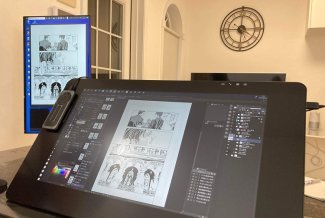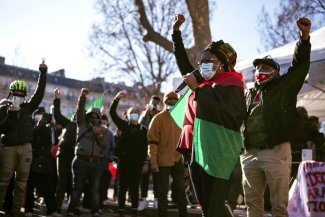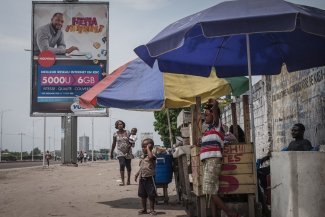M sat for hours, waiting until the other women had finished telling their stories. When they had all left, she began to tell hers. “We could hear the cries of the women in the room next door. They would shout and shout! I remember that the interrogations were held in Room Number Two. We would hear the women in that room shouting: ‘Oh my God, my God! They’re going to come and rape us.’ And I would say: ‘For the love of God, when are they going to let us get some rest?’”.
As we sit in the now half-empty building, in Reyhanli close to the border with Syria, the young Syrian woman, aged 30, bursts into tears on recalling how she was tortured and raped day after day, in 2012, by the Fourth Armoured Division in Hama. She takes a deep breath and murmurs ‘Allah, Allah!’.
She is one of over 76,000 people, according to the United Nations High Commissioner for Refugees (UNHCR), who have received psychological support for sexual violence, in Turkey, since the start of the war in Syria in 2011. Around 64 per cent of them are women, the rest are men, and most of them are activists or related to members of the opposition.
Around 90 per cent of this violence was carried out in the regime’s jails, according to Amnesty International, based on data from the Syrian Network for Human Rights, and a small percentage of radical opposition groups, such as the so-called Islamic State (IS) or Jabhat Al-Nusra, which is linked to Al-Qaeda.
In March, the United Nations published a report based on the testimonies of 454 survivors and witnesses of the gender-based violence perpetrated largely by the Assad regime, in prisons, homes and at checkpoints, and, to a lesser extent, by opposition groups such as Hay’at Tahrir al-Sham (formerly Jabhat Al-Nusra) and IS.
The Chamber of Horrors pales in comparison with the details of the report: gang rapes, rape with objects, electric shocks on the genitals, childbirths that end in deaths, and bodies piled up in cells. According to the United Nations Human Rights Council, these atrocities constitute war crimes and crimes against humanity.
In 2013, Women Under Siege published, during the early years of the conflict, statistics regarding these crimes against humanity: 83 per cent of women and 43 per cent of men were raped.
The victims of gender-based violence, or the “survivors”, to use the therapeutic term, explain in clinical detail the torture and violations suffered, the days, the hours, the torture suffered by others. Every so often, one of them bursts into tears, and the others follow, stifling the sobs at first, then crying out loud. They are reliving a horror that seems to have no end.
Some of them say they do not need therapy, that they are fine. But M has made several suicide attempts since she was released. “Sometimes I call my therapist and tell him I want to die. I have nightmares, panic attacks, sometimes I can’t breathe.”
Having listened to the stories it is hard to imagine how their lives can be rebuilt.
This is the task taken on by Jalal Nofal, a 55-year-old Syrian psychiatrist who was also imprisoned by the regime on four occasions until 2014. Nofal is now working in the border city of Gaziantep (in the south-west of Turkey) on a joint project led by Syrian civil society organisations and the Red Crescent, aimed at systematising access to psychosocial support for displaced Syrians.
“The first thing I can say, is that we don’t have enough support for everyone,” says Nofal, who forged his skills as a psychiatrist between 2002 and 2007 in a UN team giving psychological support to the Iraqi refugees who were arriving from Syria at the time.
Veiled therapies, to protect the survivors
Providing psychological support in conservative Sunni areas is a huge challenge. Rape is considered to be a dishonour for the entire family. That is why the regime uses it as a weapon of war. Some of the NGOs providing support for women in opposition-controlled Idlib, in the north of Syria, have seen their premises destroyed by Salafist groups. Sources from these organisations explain how they have had to disguise their support services as sewing workshops, for instance, for safety reasons.
Nofal approaches the victims indirectly. “We don’t have a specialised centre for men and women who have suffered rapes and torture, because it would be a stigma. No one would come to a specialised centre for former prisoners because it would imply they were weak. They always say they are fine. Our approach is confidential. People trust me because they know I also took part in the revolution and that their secrets are safe with me.”
The victims present symptoms of depression, anxiety, somatic pain, withdrawal, paranoia and psychotic thoughts. “They think they are being spied on. They sometimes think I’m an intelligence agent when I approach them,” says the therapist.
Nofal has trained around ten professionals to provide psychological support to the hundreds of survivors in Damascus, Hama, Latakia and southern Turkey. No distinction is made between rape and humiliation.
“A man who is humiliated by soldiers in front of his wife and daughters, or a woman who is made to walk naked in front of her neighbours present the same symptoms as those who are raped.”
The project on which Nofal is working combines psychological support and medication (antidepressants, antipsychotics, sleeping pills and vitamins), aimed at strengthening the victims’ psyche. “The first thing we have to do is to believe everything they say. We work with an approach that focuses on building resilience rather than on the traumas experienced. The trauma-informed approach sees people as victims, and that is very destructive. Under the resilience approach, they are seen as survivors. Survivors need to rebuild their strength, whilst victims always need more and more help,” explains Nofal.
The questions in this type of therapy focus on the person’s bravery and strength rather than their suffering. “How did you overcome this, that and the other? What support did you have? When we talk about torture, we don’t talk about how the person suffered, but how they coped. You are not just a former prisoner or a person who has been raped, you are a man or a woman, and now you are free. But you have been affected by a traumatic experience.”
In the case of physiologically inexplicable somatic pain, the therapists invite the survivors to express themselves verbally or emotionally, safe in the knowledge that they are in control, “because most of them feel they lost control of the situation as of the moment they were taken captive. Simply blindfolding people makes them feel they are no longer in control of the situation.”
Although Islam condemns suicide, the rate is high amongst former captives. According to the data gathered by Women Under Siege until 2013, 40 women committed suicide out of the 204 women documented as having been raped. In Nofal’s experience, the suicide figures are lower but he has witnessed many cases of self-destructive behaviour such as heavy smoking, drug abuse, reckless behaviour and self-mutilation. “This sometimes manifests itself as ‘adventurous’ behaviour, such as taking up arms and joining the Free Syrian Army. They go because they want to die in battle.”
Nofal explains that one of the signs that his patients have improved is that they gather the strength to go and start a new life in another country.
Talking doesn’t help
Part of the therapy is based on the same approach as that promoted by the Trauma Resource Institute of Claremont in California. Its executive director, Elaine Miller-Karas, is one of the creators of a model that has proved to be more effective in dealing with trauma than traditional therapy based on recollection and verbalisation. The daughter of a member of the US Navy, Miller-Karas has devoted 30 years of her working life to de-stigmatising and overcoming trauma.
“A natural disaster is not a malicious attack on a fellow human being. But war and its atrocities are committed by human beings. Many Western approaches focus on the importance of retelling the story. But on doing so, the women often suffer severe biological reactions. Even though they’re safe now. It’s the ongoing horror of post-traumatic stress wounds.”
Her Trauma Resiliency Model (TRM) has been used with the victims of conflicts and disasters in countries such as the US, Tanzania, South Africa, Nepal, China, Ukraine, Northern Ireland, Mexico, Rwanda, Darfur, Congo and Turkey, and on the border with Syria. Miller-Karas says the aim is to grow, which is why they identify community leaders and provide them with training in their Community Resiliency Model (CRM).
The model is based on understanding how the nervous system responds, and particularly the amygdala, in cases of sustained stress and attack. “The survival brain continues to respond as if there were no end to the trauma.
“When you learn to read your nervous system and the difference between feelings of anxiety and wellbeing, you open yourself up to a whole world of decisions. These skills can be used to direct your attention to a part of the body that is not stressed, in such a way that our prefrontal cortex takes back control, we come back to the present and we feel safe,” explains Miller-Karas, who prefers to speak of wellbeing skills rather than therapy.
Similar therapies such as Somatic Experiencing or Sensorimotor Psychotherapy are based on the same approach. According to the research of the TRI, a 75 per cent reduction was seen in the negative symptoms suffered by war veterans. Both Nofal and Miller-Karas describe recovery in the same terms: a reduction in anxiety and hostility, better sleep, less anguish and greater wellbeing.
Nofal recalls the case of one of his patients from Homs who lost a daughter in the war. She was depressed, anxious and he referred her to the psychosocial support services, for two to three months, in Gaziantep. “She worked so hard to get better. Now she is working and has become a great support for the rest of the community. Psychotherapy worked so well in her case. She is so resilient. I am very proud of her.”










